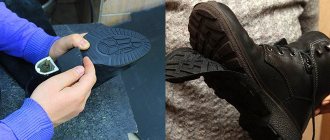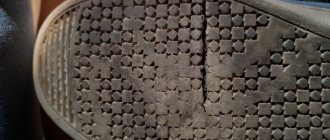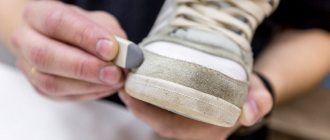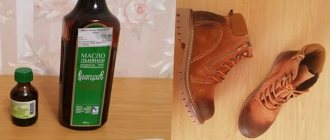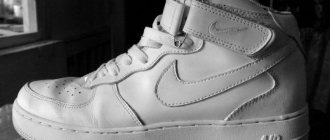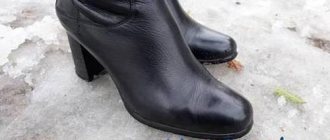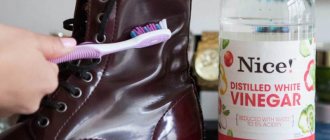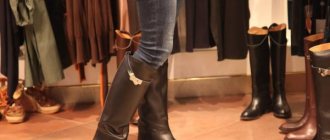Foam sponges in a plastic case, impregnated with a care composition, are among the means of rapid shoe care. They vary in size, quality of foam, working composition and durability. A new sponge will help restore an attractive shine 4-10 times, but then its working life ends along with impregnation.
Dispenser sponges last a relatively long time due to the increased volume of working composition. But at the same time, it is important that the quality of the foam rubber is consistent - the products of some manufacturers become unusable after one or two cleanings, since the sponge simply tears and crumbles.
If the cleaning composition has run out, but the sponge itself remains undamaged and is suitable for further use, its service life can be extended.
How to renew a dried out shoe sponge? What to soak with?
And now I use this oil myself, even adding it to a new shoe sponge: none of the chemicals that are intensively sprinkled on our roads are harmful to shoes.
I think that castor oil will not be superfluous for dried shoe sponge.
Light-colored (even better if they are white) rag sneakers are quite easy to care for. I can judge this by how my daughters care for them: I suggested some things, they came up with some ideas on their own.
Probably, in this matter, it is not worth recommending a specific brand of shoe care cream; It is worth mentioning the components that a high-quality cream should include. Namely, the components of the product will determine whether the shoes have acquired mud and water-repellent properties or not.
Those components of the composition that should be of primary interest are silicones, fats and wax. Of course, there should not be too much fat in the product; An unscrupulous manufacturer makes the production of shoe polish cheaper. As a result, a consumer who bought a cheap product can observe; The product leaves greasy marks when applied. And the protection of shoes after applying a cheap product is very doubtful.
Adding silicones and wax to shoe care products is another matter. Yes, such creams are not the cheapest. but the result is noticeably better. The shoes are shiny. Looks neat, like new. The shoes have dirt and water repellent properties.
These are disposable slippers made of thin polyurethane foam, similar in appearance to slates. Very convenient to use when providing pedicure services, aesthetically pleasing and hygienic.
Membrane shoes also need to be washed with a special composition (if necessary, do this with detergents). And regularly (once a week to ten days) use an impregnating spray like Luxus Anti-rain.
Source
Tips for buying winter shoes
Choosing winter shoes is much more difficult. After all, it must meet many criteria. To make it comfortable to move outside in cold weather, you should listen to the recommendations of shoe manufacturers:
- Preference should be given to soles made of soft materials.
- The tread should be wide, high enough, and include a variety of pattern elements.
- The material of the sole is also important: polyurethane or thermopolyurethane provide maximum stability on ice, while on rubber, on the contrary, you can easily slip.
- Before purchasing, perform a stability test: try bending the sole to determine its elasticity. The base should not bend easily.
Important! In case of severe icy conditions, you should purchase ugg boots, semi-sports boots or fur high boots. It's hard to stand on icy roads in stiletto heels.
Slippery shoes are uncomfortable to walk on surfaces covered with ice or snow. An ordinary walk can result in injury. To avoid having to wear a cast, you need to approach the choice of winter shoes responsibly. The sole must be stable. And if you have already purchased slippery boots, simple methods will help make them safe. The best option is to purchase ice drifts that will protect you from any kind of ice.
How do you like the article?
How to renew your shoe sponge
Foam sponges in a plastic case, impregnated with a care composition, are among the means of rapid shoe care. They vary in size, quality of foam, working composition and durability. A new sponge will help restore an attractive shine 4-10 times, but then its working life ends along with impregnation.
Dispenser sponges last a relatively long time due to the increased volume of working composition. But at the same time, it is important that the quality of the foam rubber is consistent - the products of some manufacturers become unusable after one or two cleanings, since the sponge simply tears and crumbles.
If the cleaning composition has run out, but the sponge itself remains undamaged and is suitable for further use, its service life can be extended.
Choosing a care product
Let's look at what shoe sponges are impregnated with. To restore an attractive shine to shoes or boots in slushy weather, it is recommended to use silicone-based products. They clean and lubricate the surface of the material, and also create a thin water-repellent film that protects shoes from moisture.
If the impregnation contains silicone, the protective effect after one cleaning is enough for about a day of walking in inclement weather. However, manufacturers who are chasing cheaper products often use a glycerin-based mixture instead of silicone compounds.
Glycerin does not protect against moisture and, on the contrary, aggravates the problem because it is absorbed into the skin and causes it to swell. The shine from the treatment lasts for several minutes, since unabsorbed residues are washed away by street moisture.
Thus, restoring the functionality of the sponge only makes sense if the impregnation contains silicone and wax as the main active ingredients.
If you doubt that the manufacturer has correctly indicated the composition of the impregnation on the packaging, you can check it yourself - apply the impregnation to your fingers and rub them. If you feel a slippery film, it's silicone. Glycerin is absorbed into the skin and easily dissolves in water.
Also pay attention to the quality of the foam. The durable material is elastic, has small pores, and is not prone to crumble during use. It is important that the foam is firmly glued to the lid of the case.
The high cost of a sponge does not always automatically mean appropriate quality. There are budget models with silicone impregnation that are suitable for restoring functions and can last a long time.
Traditional methods for safe walking
To walk confidently on ice, you can use traditional methods. In this case, improvised materials will come in handy. To reduce the slip of the sole, use a regular adhesive plaster, felt or sandpaper. They need to be fixed to a clean, dry surface so that they stick securely and last longer.
Adhesive plaster, sandpaper, felt
If you don’t have time to run to the workshop, you can use these simple methods:
- Adhesive plaster on a dense fabric base. Cut suitable pieces, then glue them onto the sole base. The disadvantage of this method is its short duration. The patch wears off quickly and comes off when wet. It should be updated at least every other day.
- Felt. Old felt boots are suitable, from which pieces of the required size are cut out. The material is glued to the base using glue. Service life is approximately 7 days. Felt prevents shoes from slipping even in icy conditions. However, it is useless for thin heels.
- Sandpaper. It is better to take a skin on a fabric basis. The cut pieces are glued to the sole, not forgetting the heel.
Advice! The adhesive tape strips will be less noticeable if you color them with black cream or a waterproof marker.
Sand, glue, molten nylon
To reduce the slipping of shoes on ice, you can resort to more effective methods. The work should be done carefully and slowly, otherwise the boots may be damaged. You will need coarse sand, moisture-resistant glue or regular nylon. The sole should be pre-washed, dried and degreased with alcohol. It is better to prepare in advance, and not before going out.
When the roads suddenly become covered with ice, you can use one of the following methods:
- Moment glue is applied to the surface in the form of a mesh and immediately, until it dries, sprinkled with sand. The shoes are left to dry for 2-3 hours so that the layer is well fixed. This anti-slip coating lasts for 3-5 days. Then the procedure must be repeated.
- The sand is heated in the oven to a high temperature. Take out a baking sheet and place your shoes on the hot sand. The grains of sand should stick to the surface.
- Melted nylon will help make the sole non-slip. A small piece of nylon is cut out of an unnecessary stocking and set on fire. Holding it over the sole, drip over the entire surface. Hardened tubercles will prevent sliding.
Radical methods
In severe ice conditions, you can use radical methods. To avoid damaging your shoes, you need to act carefully. The following methods will be useful:
- Using a hot soldering iron or metal rod, draw a pattern on the base of the platform. Thanks to the furrows formed, it will become rough.
- Small screws or bolts are screwed into the thick sole. Ends that are too long are cut off. This method reliably prevents slipping, but causes inconvenience due to the rattling of screws. If you walk on linoleum or parquet in your shoes, you can scratch the surface.
- The slippery sole is rubbed with fine-grained sandpaper or a grater to obtain roughness. The procedure must be repeated periodically.
- The plantar surface can be scratched with a nail. It will become grooved and less slippery.
Important! The sole must be cleaned regularly. When dirt gets between the raised protrusions, the surface becomes smooth and slippery. This effect will be eliminated by the usual care procedure.
Socks, potatoes, ice drifts
To prevent slipping, wear thick socks over your boots. The method is quite effective, but unaesthetic. You can use another folk method, for which you will need potatoes. The plantar surface should be rubbed with a tuber cut in half. Thanks to the starch that potatoes contain, a thin, rough layer forms on the surface. This method is not considered the most effective, but in a hopeless situation it can be used.
Ice drifts are special removable devices with metal spikes. They are worn as needed. You can be 100% confident in the effectiveness of ice drifts. There are models designed for children. Ice drifts adhere tightly to the surface and do not cause discomfort when walking. They are designed for a flat platform, but you can find examples for boots with heels.
The advantages of ice drifts include the following features:
- reliability;
- suitable for any shoe size;
- durability;
- invisible while walking.
Basic update methods
If you have at your disposal a suitable shoe sponge with a dispenser in which the working composition has run out, or without a dispenser, the easiest way is to purchase a special impregnation product designed for such cases. The composition of such liquids includes wax, cream-gel and other components.
A bottle of branded product lasts for a long time. The impregnation liquid is dripped onto a sponge and rubbed over the surface, or poured into the dispenser by removing the upper part of the body using a flat screwdriver.
Silicone grease in a can, which can be purchased at a car store, will also help to renew the sponge. But it is important to choose a product that is used to care for the interior, including leather - carefully study the information from the manufacturer. Only in this case is there a guarantee that the shoes will not be damaged by the treatment.
Silicone from a can is sprayed onto the surface of the sponge, after which it is suitable for use. By treating the foam rubber in the case, you will receive a compact, easy-to-use shoe care product for use throughout the day.
Silicone oil packaged in small containers is sold in hardware stores, radio stores, and other retail outlets. Silicone oil is used to clean up shoes. A 10 ml container is enough to refill the sponge 4-5 times.
Instead of special impregnation or silicone, it is also possible to use regular castor oil - this is a classic way to care for leather shoes.
Source
How to properly care for shoes at home
If a person has clean shoes, a good impression is formed about him. And in order for it to maintain its appearance, you need to be able to care for it.
Caring for suede shoes
Suede is a capricious material. Immediately after purchase, suede shoes should be treated with a water-repellent spray. And it doesn’t matter whether they are winter shoes or summer shoes. This treatment helps protect shoes from moisture.
When cleaning suede and nubuck shoes, it is best to use special rubber brushes with metal “combs” and an eraser. Such shoes cannot be washed, as this will quickly cause the material to lose its original appearance. In case of contamination, it is better to use special means and, for additional protection, treat it with a water-repellent spray at least once a month. You need to maintain a rich color using coloring aerosols.
These recommendations are relevant for light and dark shoes.
Leather shoe care
Shoes made of genuine leather are expensive. Therefore, in order for it to last longer and not lose its appearance, it needs to be properly cared for.
Immediately after purchase, it should be impregnated with water-repellent agents. For polishing, use matte or glossy shoe polish.
You need to dry your shoes in natural conditions, away from heating devices. If possible, you can purchase a dryer with ultraviolet radiation.
For cleaning, do not use acetone, gasoline, or nail polish remover. Do not wash shoes in a washing machine, as they may lose shape and color. Do not use rough brushes, as this can damage the skin.
Caring for nubuck shoes
Nubuck is a fine-haired leather that, during the dressing process, is subjected to chrome tanning and sanding of the front surface with fine-grained abrasive sandpaper. Nubuck is similar to suede, but is usually made from cattle leather.
Source Wikipedia
Unlike suede, nubuck is afraid of water. If your shoes become dirty, you will only have to clean them dry. Using detergents will ruin your shoes.
Caring for textile shoes
Immediately after purchase, shoes should be impregnated with a special impregnation and in the future this will need to be done after each cleaning.
To clean shoes, it is best to purchase special shampoos, sprays, and brushes. They will help you cope with dirt better and maintain a good look longer.
If your shoes are heavily soiled, you can wash them in cold water and soap in a washing machine on the “delicate wash” setting. It is prohibited to use chlorine-containing products.
To protect shoes from negative influences, it is recommended to treat them with special impregnations, which are available in the form of spray and foam. But when choosing them, you should take into account the manufacturer’s recommendations, since a large number of different textile materials are used to make shoes.
Caring for shoes made of synthetic materials
These shoes do not require cream treatment. It is better to clean it with a silicone brush. To prevent it from getting wet during rain and slush, it must be protected with water-repellent agents.
It doesn’t matter what material the shoes are made of, in order for them to last as long as possible, they must not only be looked after, but also protected:
- Take off your shoes without stepping on the heels;
- When putting it on, use a special spoon;
- When you take it off, unzip it all the way and untie the laces;
- Don't wear suede shoes in slush.
Caring for combination shoes
If the shoes are combined and consist of different fragments, you can clean them with a toothbrush. This will allow you to apply different products to each area.
Caring for patent leather shoes
It can only be treated with soft cloths. In order for such shoes to serve for a long time, they should be regularly moistened with special sprays and protected with appropriate wax.
Caring for faux leather shoes
You can care for such shoes in the same way as natural ones. But instead of products with natural ingredients, such as beeswax, you should use silicone-based creams.
Caring for rubber shoes
It is very easy to care for these shoes. To make it look fresh, it is often enough to simply rinse it under running water or wipe it first with a damp and then a dry cloth.
How to Renew Dry Shoe Sponge
There are these things called shoe sponges, and I really like this invention. On average, such a sponge works for about a week. It could be more, but it runs out of silicone oil. What kind of substance is this, and where can I get it?
After scouring the Internet, I found several ways to restore shoe sponge.
Method 1
Liquid for impregnation of shoe sponges Dass"
It appears to be a clear, thick liquid. The composition says it contains cream-gel, wax components, and dyes. This is a question about dyes, of course. It's not there because it's transparent.
How to use? Take an old sponge, drip as much as you see fit, and rub it until it is absorbed. You can rub it in directly with your hand, but make sure there are no drips. By the way, this liquid has no expiration date. And it lasts for a very long time!
Method 2
Add a few drops of castor oil to a dry sponge. I remember how my dad always lubricated his leather shoes with castor oil in slushy weather (as well as in heavy snow and frost): his shoes always shone and no dirt stuck to them. As they say, it flowed like water off a duck's back :-)
Method 3
Is the cooler (fan) humming in the system unit?
Add two or three drops of this lubricant, and for six months to a year you will be free from such problems. Due to chemical inertness and stable viscosity even at high temperatures, this lubricant significantly extends the life of the cooler.
| Categories: | HANDCRAFTS/Shoes HOME/Useful tips for the home |
Tags:
useful tips
Cited 1 time Liked by 1 user
Source
